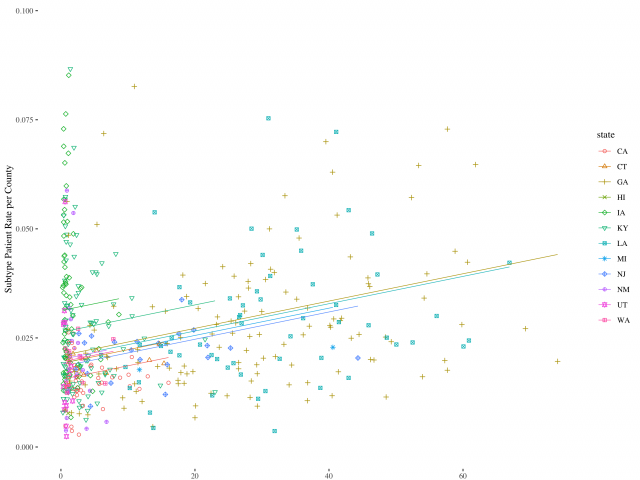
Background:
Higher prevalence of triple negative breast cancer (TNBC) in black women with associated poor outcomes due to various disparities is well documented within a single state. We examine multiple states to better understand the state effect on such differences in incidence and prevalence of TNBC in black women.
Methods:
Female patients of ages 19 years old and above with breast cancer from the Surveillance, Epidemiology and End Results (SEER) Program across 13 states (608 counties) from 2015 (n = 66,444) and 2016 (n = 66,122) were examined. The relationships between the proportion of black and white women and the rate of patients with different tumor subtypes (luminal A, luminal B, HR-HER2+, and triple negative) were examined at the county level using ordinary least-square regression models. In parallel, due to consideration of various state-specific healthcare policies, socio-cultural norms, and socio-economic disparities, multi-level regression models were applied to examine the nested, random effect of each state on TNBC prevalence in each county. Bonferroni correction was applied to reduce the Type I error caused by repeated use of the same variables in multiple tests.
Results:
The baseline breast cancer rates between black and white women were similar in the population (0.171% for black and 0.168% for white). Consistent to previous studies, we demonstrate a significant positive correlation (p < 0.001) in TNBC in black females in both years. Surprisingly, when accounted for the random effects on states, 38.2% (2015) and 34.3% (2016) increase in incidence of TNBC in black females were seen, suggestive of state-specific disparity affecting race-specific health. In 2015, other subtypes of breast cancer in both black and white females did not result in significant relationship. Interestingly, in 2016, there was a significant relationship seen between the TNBC rate in white females and the white female population rate only after adjusting for the state effect (p = 0.026). This indicates the impact of non-biological factors such as state-wide health policies. Additionally, HR-HER2+ black females had a significant relationship against respective population rate only after adjusting for the state effect as well (p = 0.0394). For luminal A white females, a 15% decrease in incidence was seen after adjusting for state effect (p = 0.0424).
Conclusions:
This is the first known across-state examination of breast cancer subtypes by race with random effects on state. This study shows the role of state-specific factors affecting incidence in black and white females and potentially indicates the importance of state-level management for breast cancer on health disparities in addition to race-driven effects. Further studies are needed to elucidate comparable differences between states affecting the rates of various subtypes of breast cancer and thus health outcomes.
Jeon, H., Lee, M., & Jaloudi, M. (2021). Geographical disparities of incidence and prevalence of triple-negative breast cancers: Multistate study data analysis. Journal of Clinical Oncology. e12599. 39(15_suppl). DOI: 10.1200/JCO.2021.39.15_suppl.e12599